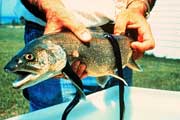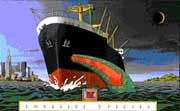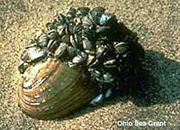
skip to content program navigation
| Learn more about these OCEAN and COASTAL RESEARCH areas... |
Aquatic Invasive Species
Aquatic Invasive Species pose an ever-increasing threat to the health of our Nation's ecosystems. NOAA's mission to protect, restore, and manage the use of U.S. ocean, coastal, and Great Lakes resources drives its program to reduce economic and environmental impacts resulting from aquatic invasions.
What are Aquatic Invasive Species?
Aquatic Invasive Species (AIS) are aquatic and terrestrial organisms and plants that have been introduced into new ecosystems (i.e. Great Lakes, San Francisco Bay, Florida, Hawaii) throughout the United States and the world and are both harming the natural resources in these ecosystems and threatening the human use of these resources. AIS are also considered to be "nuisance" species or "exotic" species and the terms are often used interchangeably.
A major threat to the health and survival of all coastal ecosystems arises from the introduction of exotic species via the ballast water of oceangoing ships, intentional and accidental releases of aquaculture species, aquarium specimens or bait, and other means. Foreign invaders like the green crab, zebra mussel and Pacific jellyfish have displaced native species and diminished biodiversity, resulting in huge economic impacts and fundamental disruptions of coastal and Great Lakes ecosystems.
Background
Legal mandates charge NOAA with developing a program for aquatic invasive species prevention, monitoring, control, education and research to prevent introduction and dispersal of aquatic invasive species, to disseminate related information, and to provide leadership in the coordination of federal invasive species efforts. Under the legislation, NOAA serves as the co-Chair of the Aquatic Nuisance Species Task Force, an intergovernmental organization dedicated to preventing and controlling aquatic nuisance species, and implementing the Nonindigenous Aquatic Nuisance Prevention and Control Act (NANPCA) of 1990. NOAA Research leads the coordinated NOAA-wide invasive species program through leadership under two significant research, outreach, and education programs: The National Sea Grant Aquatic Nuisance Species Program and the GLERL Nonindigenous Aquatic Nuisance Species Program.
Sea Grant was among the first to respond to the zebra mussel invasion of the Great Lakes in the 1980s and the recent Pacific jellyfish invasion of the Gulf of Mexico. Sea Grant continues to respond with integrated, multi-state programs of research, outreach and education, and it has increased public awareness of the rising rate of "biopollution" by foreign species through conferences, information clearinghouses, newsletters and comprehensive Web sites, including www.sgnis.org.
Today, NOAA Research works at the local, state, national and international levels to address the AIS problem and the impacts AIS have on the environment, commerce, and trade using a six-part approach: prevention, monitoring and early detection, rapid response, control and management, restoration, and leadership and coordination.
The 2008-2012
National Invasive Species Management Plan ![]() ,
developed collaboratively by 13 federal departments and agencies and
their partners, was approved at an August 1st, 2008 meeting of the
National Invasive Species Council. The 2008-2012 Plan is a “road
map” for NOAA and other federal partners to focus upon five strategic
goals: Prevention; Early Detection and Rapid Response; Control
and Management; Restoration; and Organizational Collaboration.
,
developed collaboratively by 13 federal departments and agencies and
their partners, was approved at an August 1st, 2008 meeting of the
National Invasive Species Council. The 2008-2012 Plan is a “road
map” for NOAA and other federal partners to focus upon five strategic
goals: Prevention; Early Detection and Rapid Response; Control
and Management; Restoration; and Organizational Collaboration.
Prevention
It is much less costly to prevent an introduction then to eradicate an already introduced species. For this reason, much research is focused on technology to prevent introductions. The primary mode of introduction of foreign invaders into and between bodies of water is in marine vehicles, structures and systems associated with the water-bore segment of world trade. As new problems are discovered, innovative and revolutionary marine environmental engineering solutions will be required. Sea Grant, GLERL and our Joint Institute partner, the Cooperative Institute for Limnology and Ecosystems Research at Michigan State University, are dedicated to fostering research to demonstrate ballast water technology and marine engineering advances to combat ANS.
Monitoring, Early Detection, and Rapid Response
Technology will never be able to prevent the introduction of all species. For this reason, it is essential to conduct ecosystem monitoring in a timely and systematic manner in order to detect introductions early enough that a rapid response is feasible. Often the only way to successfully eradicate an invasive species is to take action very early in the invasion process before an infestation becomes widespread. Failure to respond rapidly to an incipient invasion may result in permanent control expenditures.
Restoration
Restoring ecosystems is crucial in order to prevent reinfestation of invasive species. Research is needed to improve understanding of the biology of invasive species and the effects of invasions, and to improve development of new restoration tools. For this reason, the NOAA program encourages the development of restoration tools and works to disseminate information about effective and cutting edge restoration techniques to coastal community leaders and managers.
Two sea lamprey, an aquatic invasive species, hang attached to a fish. Lamprey entered the lakes in the 18th century when canals were built to expand shipping access in the region. Soon after, significant commercial fishing industries plummeted as lamprey preyed on fish species. Photo credit: U.S. Geological Survey
With the expansion of worldwide shipping, the transport of invasive species via ballast water tanks on ships is now the most significant pathway of introduction of aquatic invasive species into marine ecosystems.
Education is often the best prevention method to reduce the spread of invasive species. This Sea Grant video titled "Stop Exotics: Clean your Boat", designed to teach recreational boaters to remove hitchhiking organisms from boat hulls, is just one of many tools used to prevent invasions.
Since zebra mussels first invaded the Great Lakes in 1988, research has centered on understanding the impacts these mussels have on the Great Lakes' economy and ecology. Here, a cluster of zebra mussels is attached to a native clam. Photo credit Ohio Sea Grant |
NOAA Research programs that study Aquatic Invasive Species:
![]() National
Sea Grant Program
National
Sea Grant Program
![]() Great
Lakes Environmental Research Laboratory
Great
Lakes Environmental Research Laboratory
Additional Related Information: |
| The National Sea Grant Aquatic Nuisance Species Program Sea Grant Project Search (Search the Sea Grant database for projects that have been funded.) Great Lakes Environmental Research Laboratory Nonindigenous Species Research Program Great Lakes Aquatic Nonindigenous Species List Cooperative Institute for Limnology and Ecosystems Research (CILER) National Invasive Species Council NOAA Research Spotlights from the Spotlight Archives:
|




